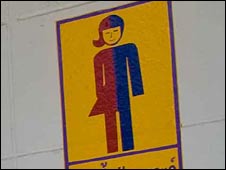Archive for the year 2008
Way out

.
.
Following on from the previous couple of entries, and mulling over as to what it really is that makes a young Thai boy decide to become a ladyboy, I decided to ask the opinion of my maid. Not only is she a fount of information on all things that relate to the Thai working class – which forms the vast majority of the population – but as regular readers of this site will know, she has a son who is a ladyboy. Consequently, she has a huge number of ladyboy acquaintances, and knows a large number of families with ladyboy members.
She confirmed what I had long suspected, that many young Thais become ladyboys as a way of attempting to escape from poverty. Although for us from the Western cultures it is hard to understand how changing one’s sex is a route out of an impoverished life, we do not really understand just how hopeless life can be for a young Thai man from a poor background and with limited education.
My maid told me about the large number of young men, many of them from the rural northeast of the country, where she herself comes from, who go to work in the gay bars of Bangkok, Pattaya, Phuket and other tourist destinations. She said they are usually not gay, but that by working in a bar and going with a foreign visitor they are able to earn as much in one or two nights as they would in a month working in the rice fields or the factories.
Ladyboys, she said, are really only carrying this idea a step further. Many of them are gay, but some are not. What they really want is a life of glamour and money. Their biggest ambition is to find a wealthy man, usually a foreigner, who will take care of them and their families. They see how girls from poor families use their beauty to make money, and bearing in mind the enormous and increasing demand for ladyboys, feel they can do the same.
As a lot of youngsters are making this decision at a very early age, usually the onset of adolescence, it is not necessarily a rational one. Little thought is given to what might happen later in life. But the attractions of working in cabaret, in one of the big red-light areas, or even mainstream in beauty salons or the media far outweigh the alternatives.
My maid added that such is the vast number of young Thai males who are now opting for work in the gay sector, or becoming ladyboys, there is actually now a shortage of eligible young men in Thailand. I hadn’t known that. But apparently it is a well-known fact amongst the Thais, and when you realise just how big this sector is, it becomes understandable.
Given the current political situation in Thailand things are not going to become any easier in the near or medium future. But one rather frightening aspect is that tourism has plunged in the wake of the political turbulence, and the international meltdown. This is also not going to improve very quickly. Which means there are a lot of young guys and ladyboys chasing a diminishing dollar.
Posted: November 25th, 2008 under General.
Tags: The ladyboy experience
Comments: none
Chemistry lesson?

.
I had a very interesting email following on from the previous entry, the reader wondering if there is any environmental factor that can be triggering genetic changes amongst young Thai males, changes that in particular affect the genitals. Over the past couple of generations, he says, during which there has been an incredible surge in the number of Thai ladyboys, there has been an enormous increase in the use of chemicals for food production.
There is also the fact, he adds, that the American government used chemicals to clear jungle during the Vietnam War. These chemicals were dropped from aircraft and could have floated for hundreds of miles in the air. The compounds could have been ingested by the Thai population, which went on to produce children who developed a genetic defect.
The reader adds that he is only speculating, but this is the kind of thought-provoking email that I enjoy reading.
My immediate reaction is that I travel regularly to Vietnam, but I know almost nothing about Vietnamese penises. I am not gay and so I do not follow the gay scene there. My interest is in ladyboys and the amount of ladyboy action in Vietnam is almost negligible. This is not to say it doesn’t exist. But Vietnamese society is more conservative than that of Thailand, and of course you have a communist government that is not dreadfully amused by what they would no doubt describe as depravity and decadence.
So, I’m not in a position to comment on the sexual proclivities and problems of young Vietnamese males.
There is no doubt that what appears to be a large number of teenage Thai boys are being served very poorly in the downstairs department. Time after time after time – and don’t forget I see an awesome number of ladyboy penises – I see a pair of panties come down to reveal a little bud of a dick, or one that clearly was never going to do what it was supposed to do ie propagate the human race.
Female hormones are sometimes to blame, and eventually of course taking hormones will remove the maleness from a penis. But this takes time, and a good strong cock will fight hard and long against the feminine tissues that start to swirl around the bloodstream of a normal teenage boy.
I really don’t have an answer. Very little real research has been carried out on the Thai ladyboy phenomenon. I think I will stick with my original premise that the majority of ladyboys are ladyboys for an economic reason, followed by teenage rebellion against society, followed by malfunctioning of the naughty bits, followed lastly by genuine transsexualism.
Posted: November 10th, 2008 under General.
Comments: 1
Missing link

.
There is an interesting story currently on the BBC website, reporting that Australian researchers have identified a significant link between a gene involved in testosterone action and male-to-female transsexualism.
DNA analysis from 112 male-to-female transsexual volunteers showed they were more likely to have a longer version of the androgen receptor gene.
The genetic difference may cause weaker testosterone signals, the researchers say.
One of the team, Professor Vincent Harley, is quoted as saying that transsexualism is still widely viewed as simply a lifestyle choice, and consequently carries a social stigma, but that the research findings support a biological basis of how gender identity develops.
One study has shown that certain brain structures in male-to-female transsexual people are more “female like”.
It is encouraging to see serious research being carried out on this subject, about which little is known. However, as I have said here before, as far as Thailand is concerned I am convinced that relatively few ladyboys are genuine cases of transsexualism. If they were, there would be something genetically askew for a disproportionately large number of people from one nation.
Read more »
Posted: October 29th, 2008 under General.
Comments: none
Double trouble

.
Not that many years ago you seldom found more than one ladyboy in the family, but with far more youngsters now taking the ladyboy route than ever before, I am finding more and more cases of ladyboy siblings. It seems that when an elder child becomes a ladyboy, the younger ones become entranced by the transformation, and decide to follow the same path. I have known families with three ladyboys, which is still a bit exceptional, but two are far from uncommon.
The other evening Bea and her “sister” May came round, and I got talking to them about why they both chose to become ladyboys. Bea is the eldest by 18 months, and she said that right from early adolescence she knew she wanted to become a ladyboy.
The family lives in Chiang Mai and is Chinese. Not too traditionally Chinese, she said, as they tended to be less conservative than Chinese families usually are.
 Click! |
And in Chiang Mai there is a huge population of ladyboys, many of them making a living in the cabarets that thrive in the Northern capital, and others working in theatre, the media and in the department stores, beauty salons and hotels. So ladyboys are not a rarity there.
Bea’s decision to become a ladyboy made perfect sense to her. She told me she felt comfortable with the ladyboy lifestyle. When she was younger, she had never had any real interest in girls, and once she started taking female hormones she said she felt natural as a girl herself.
May said she followed Bea’s development as a ladyboy with interest. When Bea was a boy, said May, she had done all the usual boyish things like climbing trees and getting into scrapes. But when Bea started to put on makeup and dress as a girl, May said that the transformation was an incredible one.
Suddenly, Bea had gone from being an ordinary brother into a hot little girl who drew looks and admiration from everyone, and who suddenly was the centre of attention in any gathering. May said that Bea became a different person. Being admired and lusted after did wonders for her self-assurance, and although Bea was still at school she was able to earn pocket money doing jobs that girls normally do, such as working part-time in the local beauty salon and waitressing.
May had always felt attracted to boys, and she tried putting on some of Bea’s clothing and sharing her makeup. Suddenly, from being the kid brother, she too was the centre of attraction. Once she started taking female hormones, encouraged by Bea, there was no turning back.
Both Bea and May are small in stature, and have the lovely pale skin that so many Chinese Thais have. On a more intimate level, they both have the most beautiful sexy bottoms. The dick shape is different. Bea has a long, thin one, while May’s is thicker and fuller. Both cum only in small amounts, although they tell me that was the case even before they started taking hormones.
There won’t be any more ladyboys coming from this family, as the only sibling left is a sister. I asked Bea and May what their sister thought about having two ladyboy “sisters”.
“No problem!” they both said. “We share each others’ clothes!”
Posted: August 15th, 2008 under General.
Comments: 4
May we be excused?

.
.
Separate toilet facilities for ladyboys have long been provided in many Thai colleges and universities, but seldom do you hear of secondary schools having transgender toilets for the pupils. This item has just appeared on the BBC website.
The comment from the headmaster as to the high proportion of transgender pupils bears out what I have been saying for some time now: youngsters are making the decision to become ladyboys at a very young age.
“With its spacious, tree-lined grounds and slightly threadbare classrooms, there is nothing obviously unusual about the Kampang Secondary School. It is situated in Thailand’s impoverished northeast, and most of the pupils are the children of farmers.
Every morning at 0800 they all gather outside to sing the national anthem and watch the flag being raised. Then they have a chance to use the toilets, before heading off the first classes of the day.
Kampang is proud of its toilets. Spotless, and surrounded by flowering tropical plants, they have won national awards for cleanliness. But there is something else about them too. Between the girls’ toilet and the boys’, there is one signposted with a half-man, half-woman figure in blue and red. This is the transsexual toilet, and outside, in front of the mirrors, some decidedly girly-looking teenage boys preen their hair and apply face cream.
The headteacher, Sitisak Sumontha, estimates that in any year between 10 percent and 20 percent of his boys consider themselves to be transgender – boys who would rather be girls.
“They used to be teased every time they used the boys’ toilets,” he said, “so they started using the girls’ toilets instead. But that made the girls feel uncomfortable. It made these boys unhappy, and started to affect their work.”
So the school offered to build the transgender boys their own facility, and they welcomed it. Triwate Phamanee is a slightly built 13-year-old who is adamant that he will one day change his gender.
“We’re not boys,” he told me, “so we don’t want to use the boys’ toilet – we want them to know we are transsexuals.”
Vichai Saengsakul, 15, agrees. “People need to know that being a transsexual is not a joke,” he says, “it’s the way we want to live our lives. That’s why we’re grateful for what the school has done.”
The transgender boys in Kampang tend to stick together as a group, practising their somewhat exaggerated feminine mannerisms together and generally camping it up. They still have to wear male uniforms, make-up is not allowed (although some manage to sneak in a touch of lipstick and mascara), and of course sex-change surgery is out of the question at this age – the youngest self-declared transsexual is 12.
But they appear to be treated perfectly normally by other pupils and teachers alike. I asked the headmaster whether they were not too young to be making decisions about their gender. He said that, in his 35 years of working in the Thai education system, he had come across many boys like this, and they never changed. Many go on as adults to have sex-change surgery, while others will live as gay men, he said.
Thailand is well known for its tolerance of transgender men, and they are very visible in everyday life. Sex-change surgery has become a speciality of the Thai health industry, and it is relatively inexpensive; patients come here from all over the world for the operation.
The Kampang school’s initiative, far from stirring up controversy, has instead prompted a discussion in other schools over whether they should be providing the same facilities. A ratio of 10 percent to 20 percent of boys calling themselves transsexual in a provincial high school does seem very high, but Mr Sitisak assured me that in his experience it was not unusual.
Which brought up a question that has been rattling around my head ever since I first lived in Thailand seven years ago: Why do so many Thai men want to become women?
I asked Suttirat Simsiriwong, who became a campaigner for transgender rights after she was barred entry to a nightclub at an international hotel in Bangkok last year. Poised, articulate and very feminine, it is hard to tell that she was not born a woman.
“Maybe the numbers of gays, of people with sexual identity issues, might be the same as in other countries,” said Suttirat, “but because Thai society and culture tend to be very sweet, very soft, and the men can be really feminine, if we tend to be gay, many of us tend to be transgender.”
So does building a special toilet in school advance the cause of winning wider acceptance for transsexuals?
“At that age it’s good for them to have a specific place,” she said. “But when they graduate from school or university, they will know how to have medical treatment. They won’t want to go into a transgender toilet because they will want to be accepted as a woman – so they will go to the women’s toilet.”
Tolerance, said Suttirat, is not the same thing as acceptance. Despite their high profile in Thailand, transsexuals complain that they are still stereotyped – they can find work easily enough as entertainers, in the beauty industry, the media, or as prostitutes, but it is much harder to become a transgender lawyer or investment banker.
And their biggest complaint is that they cannot change their legal status. Despite a proposal during the drafting of a new constitution last year, to allow them to change the gender on their identity cards, this has not yet been approved.”
http://news.bbc.co.uk/2/hi/asia-pacific/7529227.stm
Posted: July 30th, 2008 under Uncategorized.
Comments: none














